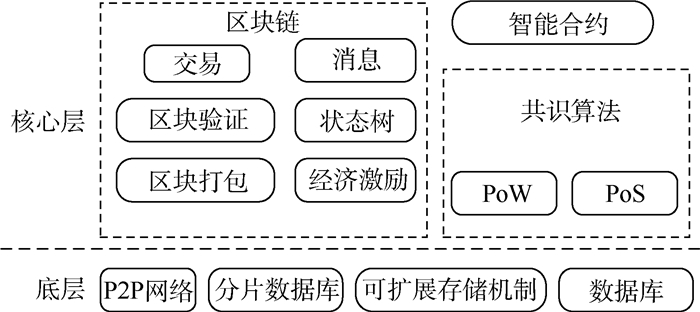-
摘要:
区块链数据持续线性增长,最终导致单个节点无法提供足够的存储资源,产生存储可扩展性问题。轻节点模型虽然极大地降低了对存储资源的需求,但是也导致全节点减少、去中心化程度降低,威胁区块链网络的安全。账户型区块链尚未有成熟的可扩展存储方案提出。考虑到状态数据的使用频率远远高于区块数据,提出一种基于账户型区块链的可扩展存储模型(SSMAB)。SSMAB以完全冗余的方式保存状态数据,保证其交易验证功能;以分片方式存储区块数据,降低冗余度;采用经济激励机制,在保证数据可用性的前提下,减少存储的消耗。实验结果表明:SSMAB模型能够保证数据的可靠性与可用性,将存储数据量降低到全节点模型的13%。
Abstract:Blockchain data is growing linearly, eventually reaching a point where single node cannot provide sufficient storage capacity, and resulting in storage scalability problems. Although the light node model greatly reduces the demand for storage capacity, it also leads to a reduction in full nodes and decentralization, which threaten the security of blockchain networks. At present, there is no mature and scalable storage solution proposed for account-based blockchains. Considering that the access frequency of state data is much higher than that of block data, this paper proposes the scalable storage model for account-based blockchain (SSMAB). SSMAB saves state data in a completely redundant manner to guarantee its transaction verification function, stores block data via sharding storage to reduce redundancy, and adopts an economic incentive mechanism to ensure data availability while reducing storage consumption. Experiments show that SSMAB can ensure data reliability and availability, while reducing storage data volume to 13% of the full node model.
-
Key words:
- blockchain /
- storage model /
- Ethereum /
- sharding /
- economic incentive
-
表 1 区块链存储方案
Table 1. Blockchain storage scheme
表 2 符号含义
Table 2. Description of symbols
符号 含义 Pr 单节点可靠性 Tw 单节点故障时间 t 请求响应固定时间 Pse 相同副本节点全部故障的概率 Na 区块链中所有节点的数量 Nm 持有相同副本的节点数量 s 序号,表示Nm个以内的节点 Tsw Nm个节点中第s个节点的平均故障时长 Pa P2P系统可用性 Ds 单分片数据量 Da 区块数据总量 Ci 分片变动价格 Cb 分片基准价格 -
[1] NAKAMOTO S. Bitcoin: A peer-to-peer electronic cash system[EB/OL]. [2020-04-31]. https://bitcoin.org/bitcoin.pdf. [2] BUTERIN V. A next-generation smart contract and decentralized application platform[EB/OL]. [2020-04-31]. https://github.com/ethereum/wiki/wiki/White-Paper. [3] CASINO F, DASAKLIS T K, PATSAKIS C. A systematic literature review of blockchain-based applications: Current status, classification and open issues[J]. Telematics and Informatics, 2019, 36: 55-81. [4] Etherscan[EB/OL]. [2020-07-04]. https://etherscan.Io. [5] ZILLIQA. The ZILLIQA technical whitepaper[EB/OL]. [2020-05-15]. https://github.com/Zilliqa/docs/blob/master/whitepaper.pdf. [6] JIA D, XIN J, WANG Z, et al. ElasticChain: Support very large blockchain by reducing data redundancy[C]//Proceedings of Asia-Pacific Web. Berlin: Springer, 2018: 440-454. [7] 赵羽龙, 牛保宁, 李鹏, 等. 区块链增强型轻量级节点模型[J]. 计算机应用, 2020, 40(4): 942-946. https://www.cnki.com.cn/Article/CJFDTOTAL-JSJY202004003.htmZHAO Y L, NIU B N, LI P, et al. Blockchain enhanced lightweight node model[J]. Journal of Computer Applications, 2020, 40(4): 942-946(in Chinese). https://www.cnki.com.cn/Article/CJFDTOTAL-JSJY202004003.htm [8] XU Z, HAN S, CHEN L. CUB, a consensus unit-based storage scheme for blockchain system[C]//2018 IEEE 34th International Conference on Data Engineering (ICDE). Piscataway: IEEE Press, 2018: 173-184. [9] ZAMANI M, MOVAHEDI M, RAYKOVA M. RapidChain: Scaling blockchain via full sharding[C]//Proceedings of the 2018 ACM SIGSAC Conference on Computer and Communications Security. New York: ACM, 2018: 931-948. [10] Rchain. The Rchain whitepaper[EB/OL]. [2020-05-12]. https://github.com/rchain/reference/blob/master/docs/RChainWhitepaper.pdf. [11] DAI Q, XV K, GUO S, et al. A private data protection scheme based on blockchain under pipeline model[C]//1st IEEE International Conference on Hot Information-Centric Networking (HotICN). Piscataway: IEEE Press, 2018: 37-45. [12] Github[EB/OL]. [2020-06-11]. https://github.com/ethereum/eth2.0-specs. [13] Bitcomet[EB/OL]. [2020-06-11]. http://www.bitcomet.com/en. [14] BENET J. IPFS-Content addressed, versioned, P2P file system[EB/OL]. (2014-07-14)[2020-06-11]. arxiv. org/abs/1407.3561v1. [15] BOREL E. Probabilities and life[M]. New York: Dover Publications Inc, 1962: 23-87. [16] Github[EB/OL]. [2020-06-12]. https://github.com/swarmpit/ethstats/. [17] PeerSim[EB/OL]. [2020-07-24]. http://peersim.sourceforge.net/. -







 下载:
下载:










